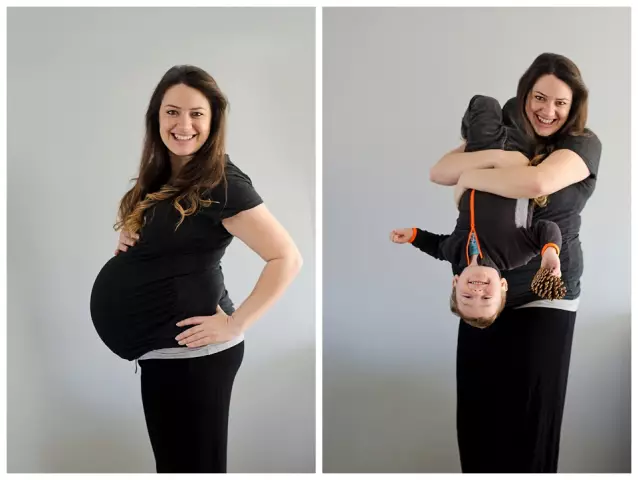- Author Rachel Wainwright [email protected].
- Public 2023-12-15 07:39.
- Last modified 2025-11-02 20:14.
16 week of pregnancy

The unborn baby at the 16th week of pregnancy turns 14 weeks from the moment of fertilization, or 4 full lunar months.
Fetal changes
The size of the fetus at 16 weeks of gestation from the crown to the coccyx is 11 cm, it already weighs 100 - 120 g.
The lower part of the body and legs of the future baby continue to increase, the length of the legs already exceeds the arms. The fetus's movements become more varied, it can keep its neck straight, turn its head in different directions.
Many organs of the digestive tract function in the "training" mode:
- Stomach;
- Liver;
- Intestines;
- Biliary tract.
By 16 weeks of gestation, the fetus has formed a constant blood composition. The formation of blood cells before this period occurred in the liver, skin or yolk sac, and from the 16th week of pregnancy, the red bone marrow of the fetus takes over the function of hematopoiesis. It is located in the cancellous bones and is responsible for the formation of blood cells throughout life. In addition, specific proteins appeared in the fetal blood serum, which, together with the antigens of erythrocytes, form the blood group.
The erythrocytes (red blood cells) of the fetus at the 16th week of pregnancy contain the so-called fetal hemoglobin. It differs from normal adult hemoglobin in that it binds better and more oxygen molecules, allowing the fetal blood to more efficiently supply oxygen to the tissues. After birth, this hemoglobin is destroyed during the first months, giving way to "adult" hemoglobin, the first molecules of which are synthesized just at 16 weeks of pregnancy.
An ultrasound scan at the 16th week of pregnancy allows you to determine the gender of the unborn baby, his external genitals by this time are usually formed according to the male or female type.
The release of hormones by the pituitary gland of the fetus at the 16th week of pregnancy even more coordinates the well-coordinated work of the internal organs and the nervous system. Nerve cells in the brain are actively growing and multiplying.
Changes in a woman's body at 16 weeks of gestation
The belly at the 16th week of pregnancy continues to increase in circumference, you cannot hide it under clothes. Thin women gain a little more weight than overweight women, but the general rule for everyone is that the gain should normally not exceed 1 - 1.5 kg per month, based on the entire period of pregnancy. The total weight gain at 16 weeks gestation is approximately 2.5 kg.
Normally, a woman should not experience any unpleasant sensations, so pains at 16 weeks of pregnancy should be very alarming. When combined with bloody discharge at 16 weeks gestation, it can be a sign of threatened termination.

Due to the increase in body size, in particular, the growing abdomen, the skin in the thighs, chest, abdomen is stretched, which is subjectively manifested by a feeling of itching in these places. Since the fibers in the connective tissue of the skin are stretched, some pregnant women develop white or pink striae in these places - narrow stretch marks.
Bumps may appear on the nipples at the 16th week of pregnancy, and bluish veins appear on the skin of the breast.
At 16 weeks of gestation, many multiparous women experience their baby's abdominal movements for the first time. They describe them as gentle touches, subtle tickling movements, or soft gurgles. Women who are to give birth for the first time will not feel fetal movements until 20 weeks.
Examination at 16 weeks of gestation
During a planned visit to the obstetrician-gynecologist of a pregnant woman, blood pressure, weight, abdominal circumference and the height of the fundus of the uterus are measured. Before visiting a doctor, a woman takes urine for a general analysis so that she can get an appointment with its result.
The doctor listens to the fetal heartbeat with a special tube. Ultrasound at 16 weeks of gestation is not routinely performed.
If a woman notices discharge at the 16th week of pregnancy from the genital tract in the form of a white curdled mass, then it is necessary to exclude candidiasis, which often occurs during pregnancy. To confirm or refute the diagnosis, you can take a vaginal swab for flora.
YouTube video related to the article:
Found a mistake in the text? Select it and press Ctrl + Enter.






